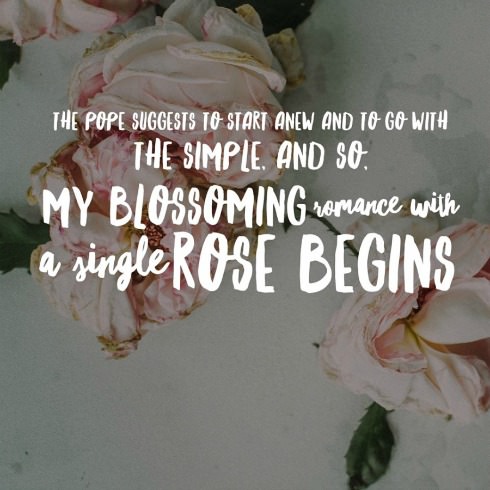 Pope Francis’ encyclical on the environment has triggered in me a dormant interest in growing roses. Why roses? Perhaps you ask. Out of so many other easier-to-grow or simpler flowers? My interest in these soft-petalled blooms still baffles me since romantic is a far cry from my staid nature.
Pope Francis’ encyclical on the environment has triggered in me a dormant interest in growing roses. Why roses? Perhaps you ask. Out of so many other easier-to-grow or simpler flowers? My interest in these soft-petalled blooms still baffles me since romantic is a far cry from my staid nature.
So here I begin my attempt to grow a single pot of roses. I want to brighten and prettify this white-washed apartment. Its plain walls and side tables need colour and fragrance, character both vintage and modern.
Real roses are a welcome change from the prior lead-lit plastic versions. They carry scents and an earthiness and velvety fabric, and a vibrancy.
I begin this journey with a cheat sheet from Google: ‘Growing roses for dummies’.
From what I construed and retained from Laudato Si’, possession of the plastic flowers stupefies the replacement of the natural, so, as I started this process for growing my very first set of red roses, little did I expect to embark on a journey of spiritual catharsis.
Roses have a reputation for high-maintenance upkeep, and perhaps I’m seduced by this challenge. It’s part of my attraction to performance.
I purchase a small pot with pure cream ceramic finish. I ponder on adding this newly acquired skill of visual merchandising to my CV. I could stage apartments at this rate.
I pay a visit to the nursery to buy water-retentive composting soil. My research tells me that poorly-drained soil invites a root-rotting party. Then insecticide. Does this fit in with Laudato Si’?
Yes, broad-based full-spectrum choice promises bad bugs’ wrathful demise, but it will follow suit with the good types. I want this to be organic, natural, free of chemicals.
It’s exhausting, all of this research. I start to wear out a little at the reminder of ecological maintenance. Oh, how easy it is to fall to the temptation of the easy-click spray option.
I finally begin by placing the ceramic pot by the window on the balcony. The promise of summer satisfies the need for ‘natural sunlight’.
I add mulch soil with inches of compost for additional nutrients and suppression of weeds.
I keep within reach some horticultural oil and insecticide soap for insect control and disease.
Instead of reverting to bud unions that serve easy entry for diseases, I attach to the mulched soil the humble beginning of a root au naturel.
I watch as it starts to bloom. It’s slow, thoughtful, considered. Further organic growth.
I smile with glowing pride at the red buds that dance with droplets of sprayed water. The thirsty petals drink in the water, and result in longevity of the red romance of nature.
Jet sprays effectively control aphids and mildew. It is vital to keep watch on tell-tale signs of disease.
Then the work of pruning and cleaning slowly give rise to blossoms, full bloom promises.
I discard the problematic ones, hard though it is to do so amidst attachment and sentiment. The deed must be done so the bud may opportune to bloom to its full potential.
As I laze on the garden chair with the cream ceramic pot on display, I smile further, capturing the warmth of the fiery bouquet,
The Pope suggests to start anew and to go with the simple, the humble. And so begins my blossoming romance with Mother Nature.
Claudia Appaduray is a Melbourne writer.